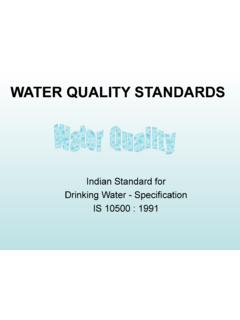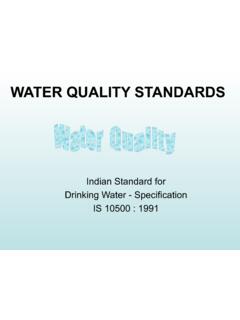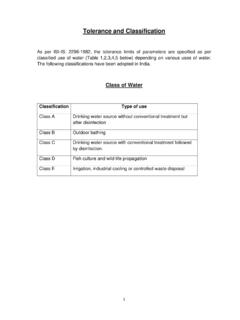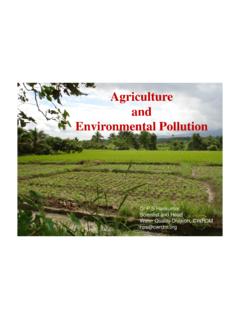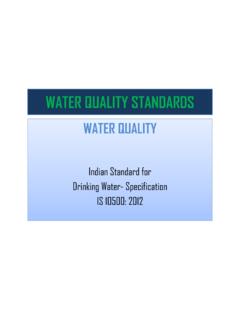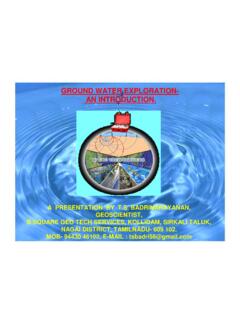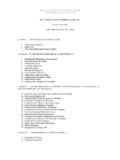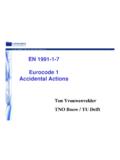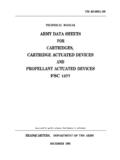Transcription of DRINKING WATER — SPECIFICATION - India Water …
1 IS 10500 : 1991. Edition (1993-01). Indian Standard DRINKING WATER SPECIFICATION . ( First Revision ). (Incorporating Amendment No. 1). UDC BIS 2003. BUREAU OF INDIAN STANDARDS. MANAK BHAVAN , 9 BAHADUR SHAH ZAFAR MARG. NEW DELHI 110002. Price Group 4. WATER Sectional Committee, CHD 13. FOREWORD. This Indian Standard (First Revision) was adopted by the Bureau of Indian Standards, after the draft finalized by the WATER Sectional Committee had been approved by the Chemical Division Council. This standard was originally published in 1983. The current revision has been undertaken to take into account the uptodate information available about the nature and effect of various contaminants as also the new techniques for identifying and determining their concentration.
2 In this revision based on experience gained additional requirements for alkalinity, aluminium and boron have been incorporated and the permissible limits for dissolved solids, nitrate and pesticides residues have been modified. A report prepared by the World Health Organization in cooperation with the World Bank showed that in 1975, some 1 230 million people were without safe WATER supplies. These appalling facts were central to the United Nations decision to declare an International DRINKING WATER Supply and Sanitation decade, beginning in 1981. Further, the VI Five-Year Plan of India had made a special provision for availability of safe DRINKING WATER for the masses.
3 Therefore, this standard was prepared with the following objectives: a) To assess the quality of WATER resources, and b) To check the effectiveness of WATER treatment and supply by the concerned authorities. During VII Five-Year Plan, 55 mini mission districts were identified with a view to meet supply of WATER to all the problem villages. The VIII Five-Year Plan intends to provide safe DRINKING WATER to the rural mass. It also propose to ensure supply of desired quality land required quantity of DRINKING WATER . While preparing this standard, the Committee had taken note of the limited testing facilities available in the country. This standard, therefore, categories various characteristics as essential or desirable.
4 The standard also mentions the desirable limit and indicates its background so that the implementing authorities may exercise their discretion, keeping in view the health of the people, adequacy of treatment, etc. All essential characteristics should be examined in routine. Besides, all desirable characteristics should be examined either when a doubt arises or the potability of WATER from a new source is to be established. It has been recognised that often it is necessary to relax the specifications, especially when no alternate resources are available and therefore, to enable the experts to exercise their discretion a maximum permissible limit has also been given.
5 In the case of virological examination, if not even one plaque-forming unit (PFU) of virus can be found in 1 litre of WATER , it can reasonably be assumed that the WATER is safe to drink. It would, however, be necessary to examine a sample of the order of 10 litres to obtain a proper estimation of the PFUs at this level. Such examinations cannot be made in ordinary control laboratories but there should be at least one laboratory in the country or region capable of carrying out virus examinations and also of pursuing further research on this subject. The methods of test for various characteristics mentioned in this standard are currently under revision and their latest revision shall be used in testing.
6 In the formulation of this standard, assistance has been derived from the following publications: a) International Standards for DRINKING WATER issued by World Health Organization, 1984. Geneva;. b) Manual of Standards of Quality for DRINKING WATER Supplies. Indian Council of Medical Research, 1971, New Delhi; and c) Manual on WATER Supply and Treatment ( third revision ), Ministry of Urban Development, 1989, New Delhi. This edition incorporates Amendment No. 1 (January 1993). Side bar indicates modification of the text as the result of incorporation of the amendment. For the purpose of deciding whether a particular requirement of this standard is complied with, the final value, observed or calculated, expressing the result of a test or analysis, shall be rounded off in accordance with IS 2 : 1960 Rules for rounding off numerical values ( revised )'.
7 The number of significant places retained in the rounded off value should be the same as that of the specified value in this standard. IS 10500 : 1991. Indian Standard DRINKING WATER SPECIFICATION . ( First Revision ). 1 SCOPE sanitary inspection and not exclusively on the The standard prescribes the requirements for results of bacteriological examination. the essential and desirable characteristics Everything possible should be done to prevent required to be tested for ascertaining the pollution of the WATER . Obvious sources of suitability of WATER for DRINKING purpose. contamination should be removed from the immediate catchment area, special attention 2 REFERENCES being given to the safe disposal of excrement.
8 The Indian Standard listed in Annex A are Wells and storage tanks should be protected by necessary adjuncts to this standard. lining and covering, surface drainage should be diverted, erosion prevented and the 3 CHARACTERISTICS surrounding area paved. Access of man and The test characteristics are given in animals should be restricted by fencing, and Table 1. should be so designed that fouling is prevented when drawing WATER . Although not supplied Bacteriological Examination through pipes, WATER from such sources is likely WATER in Distribution System to undergo further deterioration in quality Ideally, all samples taken from the distribution during transport or storage before DRINKING .
9 System including consumers' premises, should Containers used for WATER should be kept clean, be free from coliform organisms. In practice, covered and clear of the floor. The most this is not always attainable, and the following important factor in achieving these objectives is standard for WATER collected in the distribution to ensure the cooperation of the local system is therefore recommended when tested community, and the importance of education in in accordance with IS 1622 : 1981. simple sanitary hygiene should be strongly stressed. In hospitals or medical clinics with a) Throughout any year, 95 percent of such supplies, the value of some form of samples should not contain any coliform treatment is stressed.
10 Organisms in 100 ml;. Bacteriologically, the objective should b) No sample should contain E. Coli in be to reduce the coliform count to less than 10. 100 ml; per 100 ml, but more importantly, to ensure the c) No sample should contain more than 10 absence of faecal coliform organisms. If these coliform organisms per 100 ml; and organisms are repeatedly found, or if sanitary d) Coliform organisms should not be inspection reveals obvious sources of pollution detectable in 100 ml of any two which cannot be avoided, then an alternative consecutive samples. source of DRINKING WATER would be sought, whenever possible. Greater use should be made If any coliform organisms are found the of protected ground- WATER sources and minimum action required is immediate rain- WATER catchment which are more likely to resampling.
